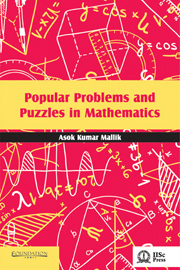Book contents
- Frontmatter
- Dedication
- Contents
- Preface
- Overview
- Problems
- Solutions
- Appendices
- Appendix I Linear Diophantine Equations in Two Unknowns
- Appendix II A Note on Private and Public Key: RSA Algorithm
- Appendix III Fibonacci Numbers, Golden Section, Golden Angle, Golden Rectangle and Golden Spiral
- Appendix IV Mathematics with Prime Numbers
- References
Appendix II - A Note on Private and Public Key: RSA Algorithm
from Appendices
Published online by Cambridge University Press: 05 October 2014
- Frontmatter
- Dedication
- Contents
- Preface
- Overview
- Problems
- Solutions
- Appendices
- Appendix I Linear Diophantine Equations in Two Unknowns
- Appendix II A Note on Private and Public Key: RSA Algorithm
- Appendix III Fibonacci Numbers, Golden Section, Golden Angle, Golden Rectangle and Golden Spiral
- Appendix IV Mathematics with Prime Numbers
- References
Summary
For secret message transfer through computer, every message is encrypted following a scrambling rule and the coded message is decrypted if the scrambling rule (i.e., the encryption key) is known. For a computer, the message (M), the key (K) and the coded message (C) are all numbers, expressed as strings of 0's and 1's. The one-way modulo function (which enables us to determine uniquely the RHS form the LHS, but not the other way round) and the difficulty of the obtaining two large prime factors (p and q) of a number N = p × q are combined to create an asymmetric key. Different keys are used for encryption and decryption.
Public Key and Private Key
Everybody knows my public key (like my telephone number). Anyone can send me an encrypted message using my public key, but only I can decipher it by using my private key.
RSA, or Rivest, Shamir, Adleman, algorithm, reported in 1976. depends on the difficulty of getting back two very large prime numbers p and q from their product N.
N (known to all) serves as the public key and p, q (known only to me) comprise my private key.
Martin Gardner (1977) asked the readers of Scientific American to find the two prime factors of a large number consisting of 129 digits.
- Type
- Chapter
- Information
- Popular Problems and Puzzles in Mathematics , pp. 121 - 124Publisher: Foundation BooksPrint publication year: 2014



